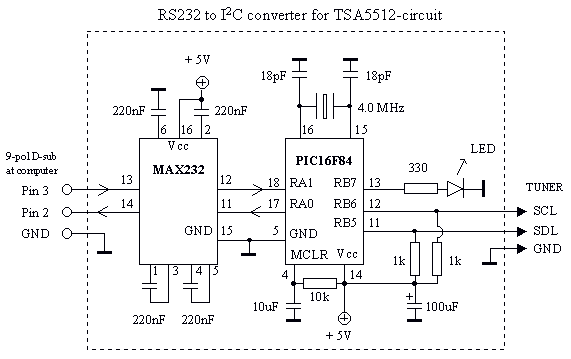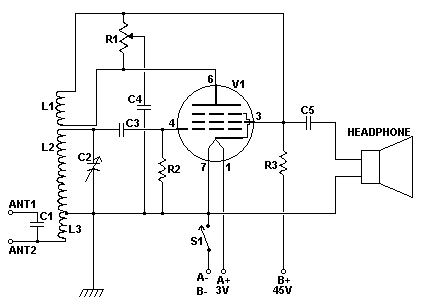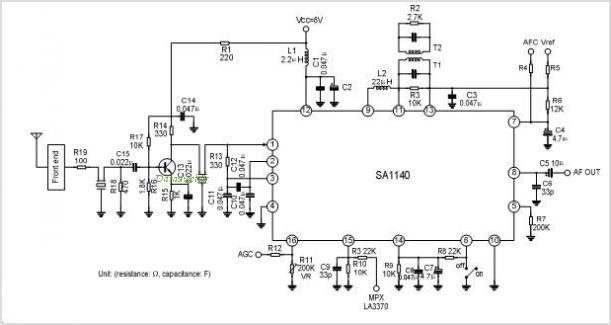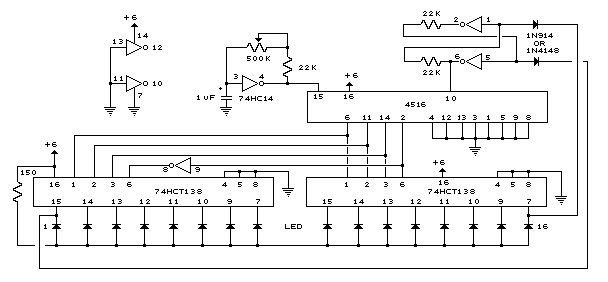
Direct Conversion AM Radio
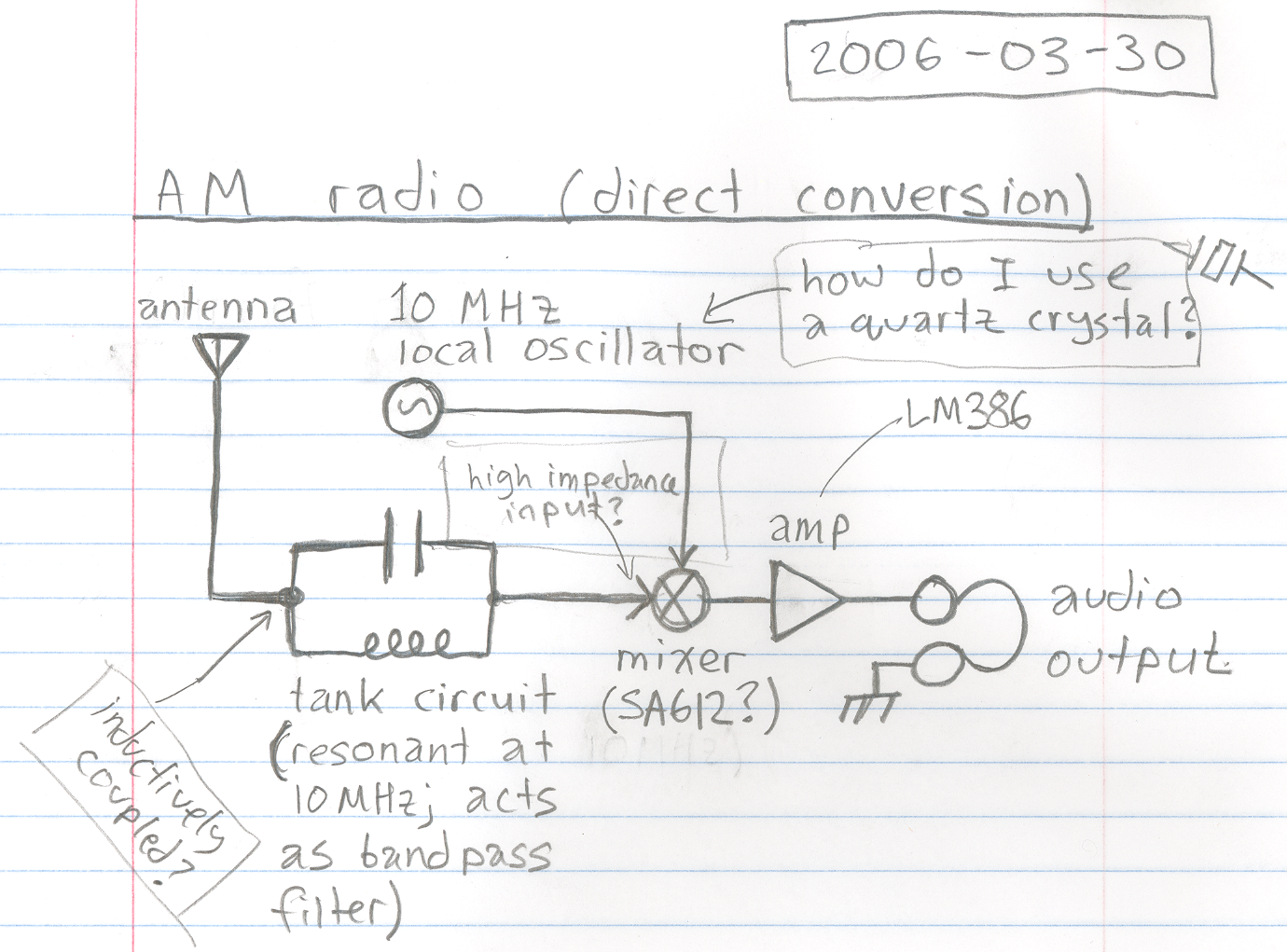
A basic design for a direct conversion AM radio receiver is being developed. "Direct conversion" refers to the technique of utilizing a mixer to shift the radio frequency signal down to baseband audio frequencies. There are uncertainties regarding the integration of the antenna into the circuit, the function of a crystal oscillator, the use of a mixer chip, and other related components.
The direct conversion AM radio receiver operates by using a mixer to convert the incoming radio frequency (RF) signals to audio frequencies. This process involves multiplying the RF signal with a local oscillator (LO) signal, which results in the generation of intermediate frequencies (IF) that are then filtered to isolate the desired audio signal. The fundamental components of this receiver include an antenna, a mixer, a crystal oscillator, and audio amplification stages.
The antenna captures the RF signals from the air, and its design is crucial for optimal reception. It should be matched to the frequency of interest to maximize signal strength. The mixer, which is the heart of the direct conversion approach, requires careful selection to ensure it can handle the desired frequency range and provide the necessary gain.
The crystal oscillator provides a stable LO signal, which is essential for the mixer to function correctly. The frequency of the oscillator must be precisely tuned to the frequency of the station being received, allowing for accurate downconversion. The output from the mixer typically contains both the desired audio signal and unwanted frequencies, which must be filtered out using appropriate low-pass filtering techniques.
The audio signal is then amplified using an audio amplifier, which drives the output to a speaker or headphones, allowing the user to hear the broadcast. Overall, the design of a direct conversion AM radio receiver involves careful consideration of component selection, circuit layout, and tuning to ensure effective reception and audio quality.A 0th-level attack at designing a direct conversion AM radio receiver. "Direct conversion" means we use a mixer (which just multiplies two signals) to downshift the radio frequency signal to baseband (audio) frequencies. I still don`t really know how to couple the antenna into the circuit, how to use a crystal oscillator or a mixer chip, or lots o
f other things. [url= [url= Conversion AM Radio [/url] by [url= on Flickr
[url= [url= Conversion AM Radio [/url] by [url= on Flickr  [url= [url= Conversion AM Radio [/url] by [url= on Flickr
[url= [url= Conversion AM Radio [/url] by [url= on Flickr  [url= [url= Conversion AM Radio [/url] by [url= on Flickr
[url= [url= Conversion AM Radio [/url] by [url= on Flickr  [url= [url= Conversion AM Radio [/url] by [url= on Flickr
[url= [url= Conversion AM Radio [/url] by [url= on Flickr  [url= [url= Conversion AM Radio [/url] by [url= on Flickr
[url= [url= Conversion AM Radio [/url] by [url= on Flickr  [url= [url= Conversion AM Radio [/url] by [url= on Flickr
[url= [url= Conversion AM Radio [/url] by [url= on Flickr  [url= [url= Conversion AM Radio [/url] by [url= on Flickr
[url= [url= Conversion AM Radio [/url] by [url= on Flickr  [url= [url= Conversion AM Radio [/url] by [url= on Flickr [url= [url= Conversion AM Radio [/url] by [url= on Flickr
[url= [url= Conversion AM Radio [/url] by [url= on Flickr [url= [url= Conversion AM Radio [/url] by [url= on Flickr  🔗 External reference
🔗 External reference
The direct conversion AM radio receiver operates by using a mixer to convert the incoming radio frequency (RF) signals to audio frequencies. This process involves multiplying the RF signal with a local oscillator (LO) signal, which results in the generation of intermediate frequencies (IF) that are then filtered to isolate the desired audio signal. The fundamental components of this receiver include an antenna, a mixer, a crystal oscillator, and audio amplification stages.
The antenna captures the RF signals from the air, and its design is crucial for optimal reception. It should be matched to the frequency of interest to maximize signal strength. The mixer, which is the heart of the direct conversion approach, requires careful selection to ensure it can handle the desired frequency range and provide the necessary gain.
The crystal oscillator provides a stable LO signal, which is essential for the mixer to function correctly. The frequency of the oscillator must be precisely tuned to the frequency of the station being received, allowing for accurate downconversion. The output from the mixer typically contains both the desired audio signal and unwanted frequencies, which must be filtered out using appropriate low-pass filtering techniques.
The audio signal is then amplified using an audio amplifier, which drives the output to a speaker or headphones, allowing the user to hear the broadcast. Overall, the design of a direct conversion AM radio receiver involves careful consideration of component selection, circuit layout, and tuning to ensure effective reception and audio quality.A 0th-level attack at designing a direct conversion AM radio receiver. "Direct conversion" means we use a mixer (which just multiplies two signals) to downshift the radio frequency signal to baseband (audio) frequencies. I still don`t really know how to couple the antenna into the circuit, how to use a crystal oscillator or a mixer chip, or lots o
f other things.
